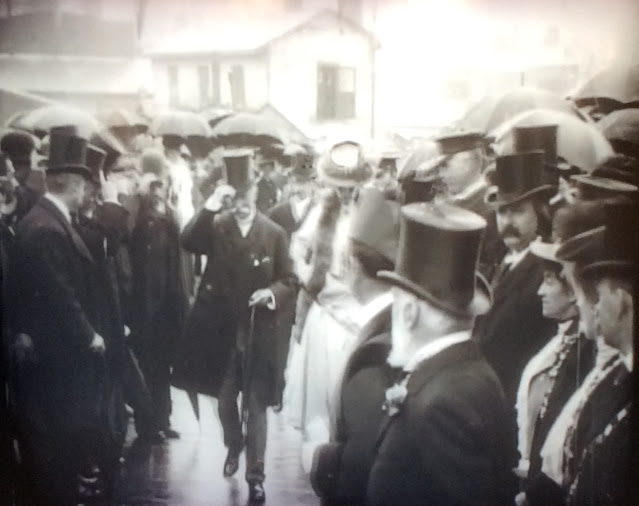A Roman Soldier Visits Newport Museum and Art Gallery
A Roman Soldier Visits Newport Museum and Art Gallery
On Thursday Verdun Howells the Education Officer at the National Roman Legion Museum visited Newport Museum and Art Gallery. Many children came to see him and talk about his life as a Roman Soldier - something about which he knew a great deal having worked at the National Roman Legion Museum at Caerleon for many years. But he was also there to talk about the Roman collection in the museum and as he was in that section of the museum he was drawing attention to the excellent collection of artefacts. It is never easy to take photographs in the Museum because of the lighting which is designed to protect the exhibits. Here is Verdun dressed as a Roman Legionary and as there was no one in this section of the gallery at the time I asked him to draw his sword. This was something he had not been able to do when other people were in the gallery for health and safety reasons, but when I visited there was no one around. Behind Verdun is a display of Roman weaponry.
Behind Verdun is part of a goatskin shield cover which was discovered in 1985 to the west of the Roman Fortress at Caerleon. See the replica above. There are also Plumbata or Matiobarbulis which are iron spear heads or throwing darts. Plumbatae are scarce in Britain but here is one from Caerwent.
On a table in front of Verdun is some replica armour which the children were able to touch and this is really important for them to experience. There was a helmet and body armour.
| ||||
Here Verdun is standing in front of a display that is important to the Friends of Newport Museum and Art Gallery because it shows the iron age head which was found in the yard area of the Roman style courtyard house at Caerwent. It is now used as our logo.
FIND SPOT OF THE CELTIC HEAD
It was found in the garden/yard area of an insula close to the West Gate.
The plan represents the top latest levels of Roman occupation. The method of excavation then was to take off the top levels and obviously as you dug deeper you went back in time so these top levels represent the later centuries of Venta Silurum (Roman Caerwent).
The creation of the Severn Tunnel brought Bristol much closer to South Wales and the tunnel opened in 1886. The Clifton Antiquarian Club decided along with the Society of Antiquaries to excavate Caerwent. They set up the Caerwent Exploration Fund and between 1899 and 1913 they excavated the site. Lord Tredegar always intended that Newport should have the artefacts and Mr Gunn, who was in charge of Newport Corporation Museum, worked hard to ensure that the artefacts came to Newport. However, you will note some artefacts in these displays, especially military examples, come from other areas of Wales as far away as Wroxeter and many examples come from Caerleon the base of the Second Augustan Legion.
Also in the display case next to Verdun you can see the sandstone altar dedicated to the Roman God Mars and the British God Ocelus. This is a cast. The altar was found at Caerwent in 1910 standing against the south wall of a house in Venta Silurum. The Romans frequently created altars which combined Roman and local deities.
Here Verdun is standing in front of the Four Seasons Mosaic which was excavated at Caerwent. Below is a water colour drawing of the mosaic created by Frank King in 1902. He was a Bristol surveyor and a member of the Caerwent Exploration Fund. It was called 'Four Seasons' because there was an effigy representing the 4 seasons in each corner. But all that was left when it was excavated was winter on the top right hand corner,
It was a brilliant idea to have Verdun in our Roman Gallery. I do hope that before long he will be able to visit us again.










Comments
Post a Comment